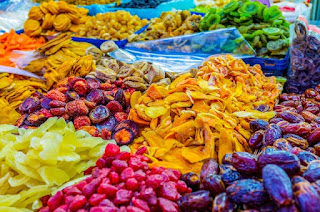Tu B’Shevat
Tu B’Shevat is considered the
beginning of the year for trees because it is the midpoint of winter: the
strength of the cold becomes less, the majority of the year’s rains (in Israel)
have fallen, and the sap of the trees starts to rise. As a result, fruit begins
to form. (Fruit that was already ripe is known to have been nurtured by the
previous year’s rain.)
updated Jan 2022
Note: I have only participated in one Tu B'Shevat seder, so I've researched the topic online to share this blog post.
The Tu B’Shevat Celebration
The Kabbalistic celebration of Tu B’Shevat that originated in Safed involves eating particular fruits in a specific order [or seder, in Hebrew] and reading mystical passages appropriate to each of them. It was first recorded in Pri Etz Hadar, a 50-page pamphlet arranged by a student of Rabbi Yitzchak Luria, the Ari (1534–1572), the greatest Kabbalist of Safed.
The First 12 Fruits of the Seder
1. Wheat is the basis for our sustenance,
but only after we labor to grow, harvest and prepare it. (Barley,
although not included in the order of the meal, is one of the seven fruits for
which Israel is praised.
2. Olives yield the best of their oil only
when the fruit is crushed. Olive oil floats on top of all liquids.
3. Dates are often a metaphor for the
righteous: the date
tree is both lofty and fruit-bearing. Also, as the date tree is impervious to
the changing winds, so too are the Jewish people.
Sterling Silver Tree of Life Necklace and Earrings Set
4. Grapes can be turned into very different sorts of food (raisins) and drink (wine); so too, each Jew has the potential to be successful in some aspect of Torah and mitzvah observance, and to be special in his or her own way.
5. Figs must be picked as soon as they ripen,
for they quickly go bad. Similarly, we must be quick to do Mitzvot (good deeds) at
hand before the opportunity “spoils.”
6. Pomegranates, it is said, have exactly 613
pips, equal to the number of mitzvot in the Torah.
7. Etrogim [Hebrew for “citrons”] are
considered to be an extremely beautiful fruit, and are import for Sukkot. The etrog remains on the
tree throughout the entire year, benefiting from all four seasons and unifying
them.
8. Apples take 50 days to ripen. So too, the Jews ripened—and still ripen—during the 50 days from Pesach to Shavuot. And just as the apple tree produces fruit before leaves, so too do Jews perform mitzvot without the prerequisite of total understanding—“We will do, and [then] we will hear” (Exodus 24:7).
9. Walnuts have two shells which
have to be removed, one hard, one soft, we too have to undergo both physical
and spiritual circumcision
10. Almonds signify enthusiasm in serving G‑d,
for the almond tree is always the first to bloom.
11. Carobs take longer to grow than any other
fruit (there is a nice story about this in the Talmud, Taanit 23a). They remind
us of the necessity to invest many years in Torah study in order to attain
worthwhile, clear understanding.
I am an Amazon affiliate
12. Pears of different strains still maintain
a close affinity (see Mishnah, Kilayim 1:4).
See this Pin from Aish.com for Seder Customs
Here's information on a TuBishvat Seder from My Jewish Learning
Comment to tell me: How YOU observe Tu B'Shevat?







Very interesting article to read about how so many fruits equate growth throughout the Jewish religion.
ReplyDeleteThanks for reading, Pam.
Delete